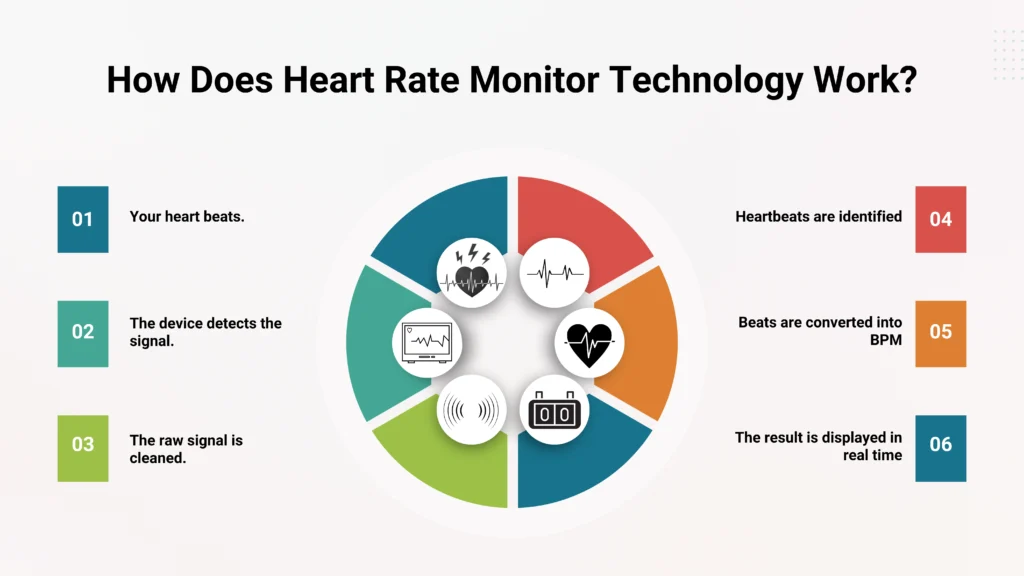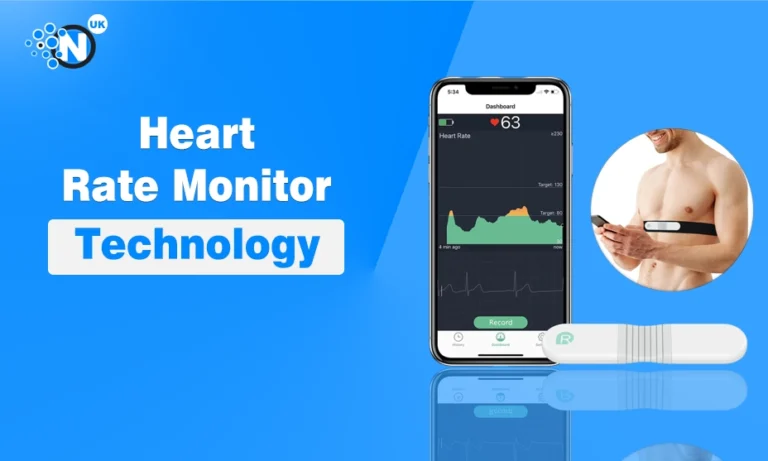I have always been fascinated by the way technology is shaping our health and fitness journey. Among the many innovations, heart rate monitor technology stands out as one of the most practical tools for tracking health and performance.
Whether you are an athlete, a casual fitness enthusiast, or simply someone who wants to keep an eye on your cardiovascular wellbeing, heart rate monitors can give you insights that were once only possible in a clinic.
In this blog post, I will take you through how heart rate monitor technology works, its benefits, and the truth about its accuracy.
What is Heart Rate Monitor Technology?
Heart rate monitor technology is a method of measuring and tracking how many times your heart beats per minute using wearable or medical devices.
The devices that use this technology work by either detecting the electrical signals of the heart or sensing changes in blood flow through the skin. Common forms include chest straps, wrist-based watches, and fingertip sensors, all designed to give real-time feedback on your heart’s activity.
This technology is widely used in fitness, sports, and healthcare to monitor exercise intensity, recovery, and overall cardiovascular health, and help people make informed decisions about their physical activity and wellbeing.
How Does Heart Rate Monitor Technology Work?

To really understand how heart rate monitor technology works, let’s break it down step by step. No matter the device, the idea is the same. Every time your heart beats, it either gives off an electrical signal or pushes blood through your body.
The device picks up that signal, translates it, and shows you your heart rate in real time. Here is how the process works in simple steps:
- Your heart beats: Each beat creates an electrical impulse and a rush of blood through your vessels.
- The device detects the signal: Some monitors capture the electrical impulse (like an ECG), while others sense changes in blood flow using light.
- The raw signal is cleaned: The device filters out background “noise” such as body movement or poor skin contact.
- Heartbeats are identified: The algorithm spots each beat or pulse by looking for the peak in the signal.
- Beats are converted into BPM: The device measures the time between beats and calculates your beats per minute.
- The result is displayed in real time: You see your heart rate number on the watch, strap, or app almost instantly.
That is the basic mechanism behind every heart rate monitor. Once you know this, it becomes easier to understand why some devices are more accurate than others.
How Heart Rate Monitors in Wearables Work?
Now, let’s look at how different devices apply the heart rate monitor technology.
1. Optical Heart Rate Monitoring
Optical monitoring is the most common technology used in wrist-based fitness trackers and smartwatches.
- Mechanism: Green LED lights are shone onto your skin, and sensors detect the amount of light reflected back. Blood absorbs more light, so with each heartbeat, the sensor picks up a tiny change in reflection. These variations are translated into your heart rate.
- Pros: Non-invasive, comfortable, and convenient for daily wear.
- Cons: Less accurate during intense workouts or when the device is loose on your wrist.
2. Chest Strap Monitoring
Chest straps are widely regarded as the most accurate consumer-grade monitors.
- Mechanism: They detect the electrical signals generated by your heart muscle with every contraction, just like an ECG. This direct measurement makes them highly reliable.
- Pros: Excellent accuracy, particularly during high-intensity exercise.
- Cons: Less comfortable for long-term, casual wear.
3. Finger and Ear Sensors
These are often used in hospitals or specialised sports testing.
- Mechanism: Like optical monitors, they shine light through the tissue (usually a finger or earlobe) to detect changes in blood flow. They are generally designed for short-term checks rather than continuous tracking.
- Pros: Easy to use for spot measurements.
- Cons: Not suitable for continuous or all-day monitoring.
Benefits of Heart Rate Monitor Technology
Now that you know how heart rate monitor technology works, let me tell you about why it is so popular. I personally believe the biggest value lies in how it helps us make smarter decisions about health, exercise, and recovery.
- Personalised Training: When I train, I want to know whether I am pushing too hard or not hard enough. Heart rate monitors allow me to stay within the right training zone, whether that’s fat-burning, endurance, or peak performance.
- Better Recovery Tracking: It is not only about how hard you train but also how well you recover. Monitoring your resting heart rate trends can reveal whether your body is ready for another tough session or if you should take it easy.
- Heart Health Monitoring: I know many people who use heart rate monitors to detect unusual patterns, such as a sudden spike at rest. This can help in identifying potential cardiovascular issues early and encourage timely medical check-ups.
- Motivation and Progress Tracking: Seeing your heart rate data on a screen during workouts can be a huge motivator. Personally, I find it rewarding to see improvements in my fitness levels when my heart rate responds more efficiently over time.
- Safety in Exercise: For beginners or people with health conditions, heart rate monitors act as a safeguard. They ensure you don’t overexert yourself and keep your exercise safe and effective.
How Accurate is Heart Rate Monitor Technology?
Similar to sleep tracking smartwatch accuracy, whenever I talk about heart rate monitor technology, the first question people ask me is: “But are they really accurate?” The answer depends on the type of device, the conditions in which you use it, and even your own physiology.
Before I break it down by device, let me point out a few factors that can influence accuracy:
- The fit of the device on your skin.
- Skin tone and tattoos (these can interfere with optical sensors).
- The intensity of movement during exercise.
- Environmental conditions like temperature and sweat.
1. Accuracy of Optical Monitors
Wrist-based monitors are very convenient but tend to be less reliable during high-intensity activities. However, for everyday tracking and moderate exercise, they are fairly accurate.
2. Accuracy of Chest Straps
If accuracy is your top priority, chest straps remain the best option. They capture electrical signals directly from the heart, which makes them almost as reliable as medical-grade equipment.
3. Accuracy of Medical-Grade Devices
Hospitals and clinics use advanced monitors that are extremely precise. While wearables cannot always match this level, they come close enough for general fitness and health monitoring.
Should You Rely on Heart Rate Monitor Technology?
After using these devices myself and learning from experts, I believe the answer is yes, with realistic expectations.
For general fitness, they are more than reliable enough. If you have a medical condition, they can still be valuable, but you should always confirm with a healthcare professional when you notice irregularities.
Final Thoughts
Heart rate monitor technology has transformed how we look at our health and fitness. It gives us real-time insights into our heart’s activity, which helps us train smarter, recover better, and live healthier. While no device is perfectly accurate, the benefits far outweigh the limitations for everyday use.
Personally, I see heart rate monitors as partners in my fitness journey, guiding me towards better decisions without replacing professional medical advice. Whether you are just starting out or already deep into fitness, exploring this technology can make a huge difference in how you approach your health goals.


